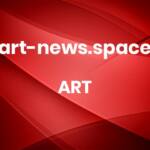Artist Christine Sun Kim used the word “homecoming” during the preview to her major new show at the Whitney Museum, titled “All Day All Night.” And it’s an apt one that takes on multiple meanings.
For starters, Kim—whose wide-ranging practice explores sound and the complexities of communicating in both her native American Sign Language (ASL) and written English—got her start at the Whitney as an educator in 2007. Kim, who was born Deaf, was instrumental in developing the museum’s programs and resources to support other Deaf audience members, notably the ASL vlogs that broadened access to the Whitney’s collection to a much wider audience around the world.
Installation view of “Christine Sun Kim: All Day All Night” at the Whitney Museum of American Art, New York, 2025. Photo: David Tufino.
“Being an educator here at the Whitney had an effect on me as an artist,” said Kim, via an ASL interpreter. “Having access to the information that the museum has—meaning access to art history—was pivotal for me. I never had that kind of access in the past. Learning what I did here, I decided to go back to graduate school, which is how I got into sound and words. For me, this was a big push in becoming an artist.”
This marks the largest show to date for the artist, after she was included in the museum’s 2019 biennial and created the content for the outdoor billboard space in 2018. “All Day All Night” is as fascinating and thought-provoking as it is expansive. It occupies the lion’s share of the museum’s eighth-floor exhibition spaces, as well as galleries on the third floor and the first-floor lobby galleries to which admission is free.
Christine Sun Kim, Degrees of Deaf Rage in Everyday Situations (2018). Courtesy Y.D.C. © Christine Sun Kim. Courtesy François Ghebaly Gallery and WHITE SPACE
Fans of her work will recognize the razor-sharp commentary in the charcoal drawing (featured in the biennial) that takes aim at, for instance, “museums with zero deaf programming (and no deaf docents/educators)” with respective ratings of “full on rage” or “obtuse rage” depending on the specifics of the situation. Another large drawing, with the self-explanatory title,, has an accompanying detailed pie chart. There are also sound experiments where vibrating surfaces on which items like paintbrushes or tacks are laid, then translated into visual marks and accompanying performance videos.
The artist uses “musical notation, infographics, and language to produce drawings, videos, sculptures and installations that often explore non-auditory political dimensions in sound,” said curator Jennie Goldstein. The works range in date from 2011 to 2024 and consider “these core concerns, as well as the importance of family, community, and the complex negotiations of shared social spaces.”
Christine Sun Kim, How Do You Hold Your Debt (2022) Collection of Jenny Osterhout and Santiago Martinez Govela. © Christine Sun Kim. Courtesy François Ghebaly Gallery and WHITE SPACE
The title “All Day All Night” refers to a motif in Kim’s work—the visualizing of ASL signs for the sun moving over the horizon and dipping below it—which has cropped up in her early drawings from 2012 as much as her recently executed canvases from 2023. The title “also points to the energy that Christine brings to her artistic practice,” Goldstein added. “She is relentlessly experimental, iterative, and dedicated to sharing her deaf-lived experience with audiences.”
L to R: Whitney curator Jennie Goldstein, artist Christine Sun Kim and Whitney director Scott Rothkopk at the opening of “Christine Sun Kim: All Day, All Night”
This is helped by Kim’s amazing ability to distill complex ideas in an accessible way, both in her work and in discussions about it. For instance, at the preview, she offered an rare view into her experience of the echo. “Yes, it’s a sound but it’s also a deaf experience that we go through,” she said. “My interpreter right now is echoing back what I’m saying… She’ll also echo what you’ll say into sign language… so my deaf experience is very echo-y.”
The artist said that despite studying graphic design for just one year, it has gotten into her mindset, and how she views the world. Perhaps not surprisingly, she nods to word-centric contemporary art star Ed Ruscha in one of the catalogue essays. The room erupted in laughter when Kim said she views the word “echo” itself as “a beautiful word,” and then added with a shrug: “It’s four letters, it’s very balanced. The E, the C, the H, the O are so cute.”
Installation view of “Christine Sun Kim: All Day All Night” at the Whitney Museum of American Art, New York, 2025. Photo: Audrey Wang.
On the Whitney’s third floor, visitors will experience this exploration of echo as it is laid out visually in drawings and murals across the walls. “The arcing black forms visualize the shape of the sign for echo,” said Goldstein, “where four fingers of one hand contact the palm of the other and then move away in a motion resembling an illustration an echoing sound wave.”
The first floor gallery presents drawings, videos, and a large kinetic installation featuring large inflated red balloons shaped like arms that reach out to touch a stone-like object. The works “explore the interconnectedness of ASL and deaf culture,” said Goldstein. She noted that some drawings consider the role that sign language interpreters play in making the artist sound different ways, while other works compare specific written English words and phrases with their counterparts in Deaf English or short hand translations in ASL.
Installation view of “Christine Sun Kim: All Day All Night” at the Whitney Museum of American Art, New York, 2025. Photo: Audrey Wang.
Kim pointed out that although this is her largest project to date, it’s “not a long-term survey. This is just a few years that we’re looking at here. I’m still getting going.”
She also noted that she left New York 12 years ago for Berlin and has now been there longer than she lived in New York. “So coming home does feel like an actual homecoming.”
Museum director Scott Rothkopf also noted in his remarks introducing the show, that Kim is the first artist-in-residence at Roy Lichtenstein’s former home and studio on nearby Washington Street, which was donated to the museum’s Independent Study Program two years ago, as a permanent home.
“The chapter that I got to have as an educator is now a full circle because I got here as an artist,” said Kim. “I am very touched and very happy to be here.”



